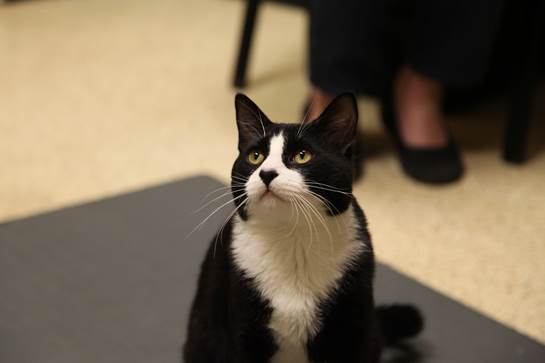The College of Veterinary Medicine (CVM) Grateful Client Giving Program is a donor recognition program that is designed to actively engage clients of the Oklahoma State University Veterinary Medical Hospital. Without the support of generous clients, you and your animal would not be able to receive the high quality, compassionate care that the Veterinary Medical Hospital is able to provide.
Areas of Impact
When you support the CVM Grateful Client, you help shape the future for Oklahoma State University. By contributing to the fund(s) below, you make our future brighter orange!
Vet Med Teaching Hospital Fund
28-83300 - This Operating Funds-Department/Program Specific fund benefits programs through CVM.
Grateful Client Giving Program
The College of Veterinary Medicine (CVM) Grateful Client Giving Program is a donor recognition program that is designed to actively engage clients of the Oklahoma State University Veterinary Medical Hospital. Without the support of generous clients, you and your animal would not be able to receive the high quality, compassionate care that the Veterinary Medical Hospital is able to provide.
The goal of the Grateful Client Program is to continue to raise support for the CVM and to recognize donors who have dedicated their giving to the hospital. When clients give through the Grateful Client Program, they honor those who have touched their lives, while supporting outstanding patient care at the OSU Veterinary Medical Hospital.



Meet Linda, a Grateful Client of OSU
Linda Wheeler came to tears the first time she saw Romano. The 6-month-old kitten, a stray who popped up in the yard of the Tulsa woman’s sister, bore a striking resemblance to a cat Wheeler had recently lost.
The only difference was Romano’s perfect heart on his nose. Was it a sign? After all, it turned out that his heart had a hole in it, which was leading to congestive heart failure. But Oklahoma State University’s Veterinary Medical Hospital came to his rescue with a first-of-its-type-in-Oklahoma procedure.

Dr. Ryan Baumwart, veterinary cardiologist, and Dr. Danielle Dugat, small animal surgeon, of OSU’s Veterinary Medical Hospital, collaborated on the surgical procedure. “The procedure hadn’t been done in Oklahoma,” Wheeler says.
“It turned into a little bit of a guessing game,” Baumwart says. We had to give Romano some drugs to keep the pressures up to avoid kidney damage and at the same time try to adjust the pressures as Dr. Dugat placed the band around the artery.”
"I am extremely thankful for the generosity of our grateful clients. Their charitable gifts facilitate opportunities that would otherwise not be possible. They allow us to continually advance patient care, enhance learning opportunities for our students and transform the future of veterinary medicine. On behalf of our faculty, staff and students, I would like to express a sincere thank you to our grateful clients for partnering with us to make OSU the region’s foremost provider of veterinary care and veterinary education."
- J. Jeff Studer, DVM, DACVO Director, CVM Medical Hospital
“Everything went the way it was supposed to because we all had our plan and everybody stuck to the plan,” Dugat says.
“That incision looks wonderful. You guys did great,” Wheeler says. “Thank you so much. Thank you so much.”

The procedure performed on Romano will allow him to live a longer, healthier life. The only alternative would be to have (very rare) open-heart surgery to correct the hole in his heart.
“To see such joy in an owner’s eyes when the procedure you perform is successful makes this a fulfilling profession,” says Dugat. “I could not have had the confidence I needed in performing this procedure for the first time if it was not for an owner who was willing to hand over the life of her baby into my hands. More so, developing a plan before surgery and understanding every individual’s important role to the success of the surgery made the execution seamless.”

